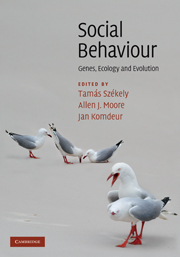Book contents
- Frontmatter
- Contents
- List of contributors
- Introduction: The uphill climb of sociobiology: towards a new synthesis
- Profile: Undiminished passion
- Part I Foundations
- Part II Themes
- Part III Implications
- 16 Personality and individual social specialisation
- Profile: Behavioural ecology, why do I love thee? Let me count the reasons
- 17 Molecular and genetic influences on the neural substrate of social cognition in humans
- Profile: Anonymous (and other) social experience and the evolution of cooperation by reciprocity
- 18 Population density, social behaviour and sex allocation
- Profile: Social theory based on natural selection
- 19 Social behaviour and speciation
- Profile: Look to the ants
- 20 Social behaviour in conservation
- Profile: The handicap principle and social behaviour
- 21 Prospects for research in social behaviour: systems biology meets behaviour
- Species index
- Subject index
- References
20 - Social behaviour in conservation
Published online by Cambridge University Press: 05 June 2012
- Frontmatter
- Contents
- List of contributors
- Introduction: The uphill climb of sociobiology: towards a new synthesis
- Profile: Undiminished passion
- Part I Foundations
- Part II Themes
- Part III Implications
- 16 Personality and individual social specialisation
- Profile: Behavioural ecology, why do I love thee? Let me count the reasons
- 17 Molecular and genetic influences on the neural substrate of social cognition in humans
- Profile: Anonymous (and other) social experience and the evolution of cooperation by reciprocity
- 18 Population density, social behaviour and sex allocation
- Profile: Social theory based on natural selection
- 19 Social behaviour and speciation
- Profile: Look to the ants
- 20 Social behaviour in conservation
- Profile: The handicap principle and social behaviour
- 21 Prospects for research in social behaviour: systems biology meets behaviour
- Species index
- Subject index
- References
Summary
Overview
This chapter develops links between social behaviour and demography, and illustrates how knowledge of social behaviour may be used to manage populations for conservation. The chapter is necessarily speculative, both because the ‘formal’ field of conservation behaviour is still only a decade old, and because explicit applications of social management are still relatively uncommon. I summarise case studies where social behaviour has been manipulated to manage populations, and suggest possible ways that behaviour could be used to manage populations. After defining effective population size, I list a number of ways that social behaviour may influence it, via genetic variation, survival and reproductive success. Reproductive skew emerges from unequal reproduction, which may be caused by (among other things) social stress, reproductive suppression and infanticide. Social aggregation may reduce natural mortality, and the observations that animals seek conspecifics may be used as a management tool to attract individuals to protected locations. But conspecific attraction and social aggregation may also predispose a population to be vulnerable to human exploitation. Social factors (including reproductive opportunities) may drive dispersal and movements between groups. Humans can influence the structure of social relationships in animals, and these manipulations may influence group stability. Knowledge of these and other mechanisms arms managers with tools to manipulate the habitat or relationships to favourably influence social behaviour and structure, and thereby better manage a population.
- Type
- Chapter
- Information
- Social BehaviourGenes, Ecology and Evolution, pp. 520 - 534Publisher: Cambridge University PressPrint publication year: 2010
References
- 7
- Cited by



